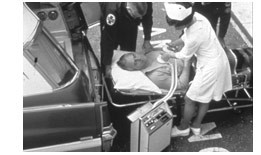1968: DEFIBRILLATOR: LIFEPAK 33 (SERIAL # 0001)
LifePak 33 – Physio-Control’s first Portable Monitor-Defibrillator
It did not take long. Physio-Control manufactured its 100th patient monitor and defibrillator in the fall of 1967, and reported revenues that year of more than $500,000. Financially, Physio-Control was near the break-even point, and Simpson told stockholders at the annual meeting in the spring of 1968, “The name of the game is now marketing.” About the same time, Physio-Control learned that Zenith Corporation was developing a bulky, but portable 56-pound monitor-defibrillator. Simpson faced the challenge head-on, assigning Stanley Seiffert, Physio-Control’s manager of technical operations, the task of designing a portable monitor-defibrillator that would be more than 20 pounds lighter. Physio-Control named the yet-to-be-built device the LifePak 33 for its target weight- 33 lbs.
The LifePak 33 was introduced at the American Heart Association Conference in Miami, Florida in 1968, but not without some last-minute difficulty. The night before the show opened, someone tried to smash two of the units. The devices were also left on, draining the batteries. But if a competitor was behind the vandalism, as many believed at the time, the publicity surrounding the “sabotage” made the LifePak 33 the star of the show.
Soon afterwards, Physio-Control was able to raise another $600,000 in venture capital, and commercial production of the LifePak 33 began in February 1969. The 15th and 45th units were sold to the U.S. Navy, which installed them aboard Air Force One and Air Force Two, the aircraft assigned to carry the president and vice president of the United States. That same year, Jacksonville, Florida, became the first city to install portable defibrillators in all 10 of its fire department emergency vehicles. Physio-Control closed out its fiscal year, at the end of September 1969, with more than $1 million in sales for the first time, although still posting a loss for the year of $35,000 because of production start-up costs.
The unit was the first portable DC defibrillator,and featured a manual defibrillator along with a small EKG scope. The device used an innovative feature called “Quik-Look” paddles which allowed the user to directly monitor the patient’s EKG rhythm through the direct application of both paddles to determine if immediate defibrillation was required. Commercial sales started February 1969. The U.S. Navy purchased two units for Air Force One later that year.
Early Mobile Coronary Care Unit (MCCU) program users of this device included the Columbus, Ohio Fire Department, the Jacksonville, Florida Fire-Rescue, the Miami, Florida Fire Department, the Seattle, Washington Fire Department “Medic 1” project, and the Metro Ambulance Service based in Marietta, Georgia, as well as the Marietta, Georgia Kennestone Hospital ALS Paramedic program.

Physio-Control went public in 1971, selling 20,000 shares of stock at $25 each. Original investors in the company purchased all but 7,000 shares. Physio-Control also launched a national advertising program built around the success of innovative Seattle’s Medic 1 project, which equipped emergency vehicles with sophisticated medical equipment, including a LifePak 33. Sales increased that year to $2.4 million, with net earnings of $266,000.
Two years later, in 1973, Physio-Control introduced the LifePak 3, a third generation of its portable external defibrillator. The company also began construction of a $2 million headquarters and research center on 11 acres overlooking the Sammamish River in rural Redmond, Washington, later to become the home of Microsoft Corporation. In 1974 Physio-Control added the LifePak 4, which featured an electrocardiogram strip-chart recorder to provide a permanent record of a patient’s heartbeat, to its growing family of portable LifePak defibrillators. Revenues that year topped $10 million, and Physio-Control posted earnings of $1.05 million.

This original LifePak 33 has serial number 0001 was donated to the National EMS Museum in 2007
The LifePak 33 was later followed by the Physio-Control LifePak 2 in 1972, the LifePak 3 in 1973, the LifePak 4 in 1974 and the LifePak 5 in 1976.
I remember carry the “33” for 4 years. It was very heavy, especially when going up 5 flights of stairs with a D tank of O2. And the paddles had a very narrow insulator around the electrodes. This made it real easy to get, “Bit” when using it. – Deathcheater (2014)
Submitted NEMSM February 2008 by Tom Barlett, additional content by Deathcheater
